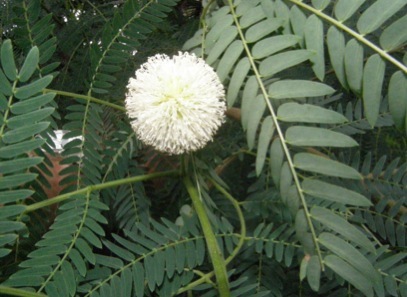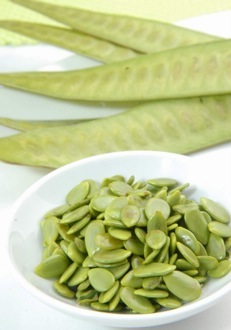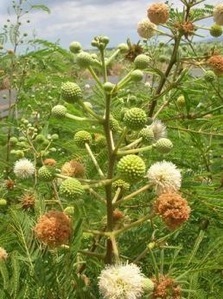Leucaena leucocephala: Food and Fodder
Professor Julia Morton, the grand dame of toxic and edible plants in Florida, had this to say about the Jumbie Bean:
“The plant is toxic to horses, donkeys, mules, and pigs, even to cattle, sheep and goats in quantity. People should not eat any parts raw.”
Not exactly encouraging. But she also says: “Young leaves, pods and seeds cooked and eaten, Mature seeds roasted and used as coffee substitute or adulterant.” Thus we start our review of the Jumbie Bean, the Lead Tree, The White Popinac, the Leucaena leucocephala.
Let’s start with the name. No great inspirations there. Leucaena (lew-KAY-nuh) means to grow white, as to flower. Leucocephala (lew-koh-SEF-uh-luh) means white headed. (Also lew-SEEN-uh.)
Also called Jumbay and the White Leadtree, this native of Central America has sporadically spread its way northwest and east from California to Florida and to the rest of the warm world. The Jumbie Bean was taken to the Philippines in the 1500’s by the Spanish, probably as cattle feed. It spread from there and has become “invasive” in Taiwan, Hawaii, Fiji and northern Australia. In the United States whether it is an invasive is a matter of debate and location.
A different attitude prevails in India where it is well-established and viewed as a resource. There it is used for firewood, fiber, lumber, charcoal and livestock fodder, the latter reported in 1998 which conflicts with Julia’s 1982 comment. Apparently the ruminant bacteria, Synergistes jonesii, helps to detoxify the fodder in multi-stomach animals. It was transferred from American stock to Australia, Africa and China starting in the 1980s to make the plant acceptable fodder in those parts of the world, as it is some 24% protein and loaded with proto-vitamin A. The stomach bacteria helps explain the advantage of multiple stomachs and why the rest of us with only one stomach and no S. jonesii have to cook the plant.
As for toxicity in the raw parts to non-cud chewing mammals, the culprit is mimosine, an amino acid. Wet or dry heat reduces the acid. If you don’t cook it Jumbie vegetation can make you sick and lose your hair, hence the old saying that it causes tails to drop off one-stomach horses.
On the positive side again the tree is a nitrogen fixer and grows very fast, as much as 10 feet a year, which is why it is a renewable firewood and good at preventing soil erosion. It is also used as a shade tree for many commercial crops including coffee, cocoa, quinine and vanilla. It is also used as a hedge to grow passion fruit on. It might be fair to suggest that whether it is a resource or a pest is a matter of attitude.
Don’t confuse this with the False Tamarind which has twisted seed pods, not straight, and cluster of flowers not solitary ones.
Green Deane’s “Itemized” Plant Profile
IDENTIFICATION: A shrub or tree to 60 feet, forked when shrubby, branching strongly after coppicing (cutting to a stump yearly.) Grayish bark and prominent lenticels. Leaves bipinnated with four to nine pairs of pinnae, variable in length up to a foot with a large gland at the base of the petiole, 11-22 pair , flowers numerous.
TIME OF YEAR: Depends on location. It can be year round in warm areas or summer time in more temperate areas.
ENVIRONMENT:Full sun, alkaline soil, enjoys humidity.
METHOD OF PREPARATION: Young leaves, pods and seeds cooked, usually boiled. Mature seeds roasted and used as coffee substitute or popped like pop corn. Dr. Morton say do not consume uncooked. A related edible species is L. esculenta.
Lastly, Leucaena glauca and Leucaena latisilique are now Leucaena leucocephala. Cornucopia II disagrees with Morton and says leucocephala young leaves, pods, and flower buds can be eaten raw, or cooked. Mature seeds but not dry seeds are eaten raw or cooked. Dry seeds are used as a coffee substitute or fermented into a tempeh like product. I’ve never tried them raw, preferring to err on Morton’s side.




